Disclaimer: This post may contain Amazon affiliate links. Sudachi earns a small percentage from qualifying purchases at no extra cost to you. See disclaimer for more info.
Featured Comment:
“Absolutely fantastic! The whole family loved it. It was my first attempt at tempura (did vegetables as well as prawns) and it didn’t turn out too bad.”
– Sandypaw
What is Shrimp Tempura Udon?
Shrimp tempura udon is a hot soup dish made with udon noodles and served with shrimp tempura. In Japan, it is often referred to as “ebiten udon” (海老天うどん).
The shrimp tempura is typically placed on top of the noodles, allowing the batter to absorb the delicious flavor of the soup.
Shrimp is undoubtedly the most popular type of tempura in Japan. On Ranking.net, shrimp is ranked as the number one ingredient among 60 others.
If you want to learn more about Japanese shrimp tempura, including what type of shrimp to use, how to prepare them, and tips for making the perfect shrimp tempura, check out my shrimp tempura recipe.
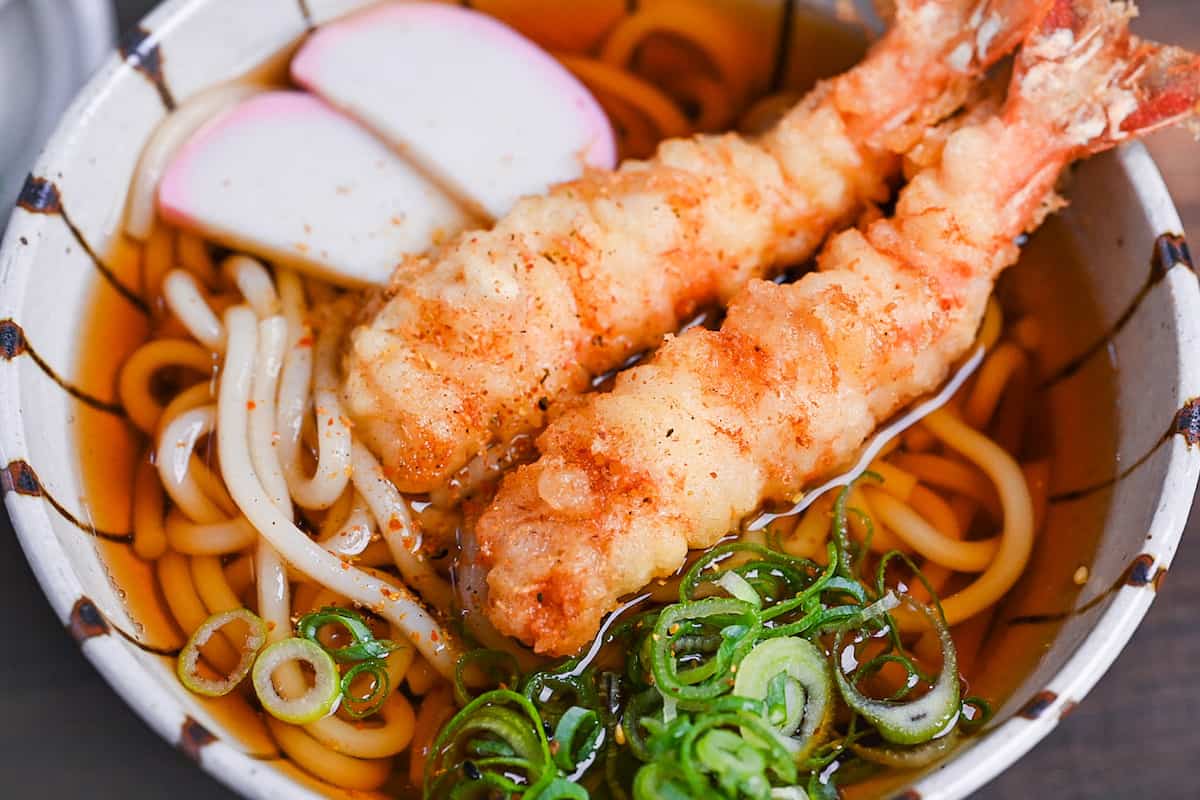

How I Developed This Recipe
Hot udon is definitely one winter treat for me. Among them, one dish distinctly stands out: shrimp tempura udon. It’s not just any udon dish; it’s my absolute favorite. From my perspective, the magic lies in the delicate combination of the crispy shrimp tempura and the soothing udon soup.
In developing this beloved dish, I poured my heart and soul into perfecting the most authentic shrimp tempura. Imagine biting into a crispy tempura, then letting it soak up the humble kake udon soup.
I think there’s something truly special about the union of udon and tempura. If you like udon dishes and tempura, please check it out!

Ingredients You Will Need
- Dashi Broth: The soul of our soup lies in the dashi. You can pick from my favorite dashi, simple awase dashi, or even a plant-based dashi. If time’s ticking, instant dashi granules or dashi packets work well too.
- Soy Sauce: If you’re looking for a reasonably priced yet authentic brand, Kikkoman soy sauce is a solid choice. For a deeper dive into the world of soy sauces in Japanese cooking, check out my complete soy sauce guide.
- Mirin: When shopping for mirin, keep an eye out for “hon mirin” (本みりん) to ensure the best taste. I recommend Hinode Hon Mirin as a high-quality and affordable option. See my 20 Most Useful Condiments and Seasonings for Japanese Cooking post for more recommendations.
- Udon Noodles: These thick wheat noodles have a wonderful chewy texture and are one of the most essential elements of the dish. Pre-boiled udon or frozen udon are good options, and dried udon tends to be thinner, but they can still be used for this recipe.
- Toppings: I’ve adorned my dish with finely chopped green onions, kamaboko fish cake, and shichimi togarashi sprinkled. But hey, there’s room for creativity! Think wakame seaweed, grated daikon, shiitake mushrooms, katsuobushi, or kitsune aburaage.
- Large Shrimps/Prawns: I personally recommend Japanese tiger shrimp, giant black tiger shrimp, or big whiteleg shrimp.
- Tempura Batter: For that authentic Japanese touch, I mix cold water, sparkling water, potato starch, cake flour, egg-containing mayonnaise, and ice cubes. Curious about the details? Dive into my tempura batter recipe.
- Cleaning Ingredients: A dash of cornstarch and a pinch of salt can work wonders in cleaning shrimp. It’s a small step with big rewards!
- Cooking Oil: Frying tempura calls for neutral oils with high smoke points, like canola, sunflower, or peanut oil. But I’ve often leaned towards rice bran oil and extra virgin (white) sesame oil for tempura fry. Many tempura chefs I’ve chatted with in Japan swear by the extra virgin sesame oil. It gives the batter a light and crispy texture but might pinch the pocket a bit.
Curious about the exact brands and products that bring my recipes to life? Discover the brands and ingredients behind my recipes at the Sudachi Amazon Storefront. Explore my handpicked pantry essentials and find your next kitchen favorites!
Jump to Full Recipe Measurements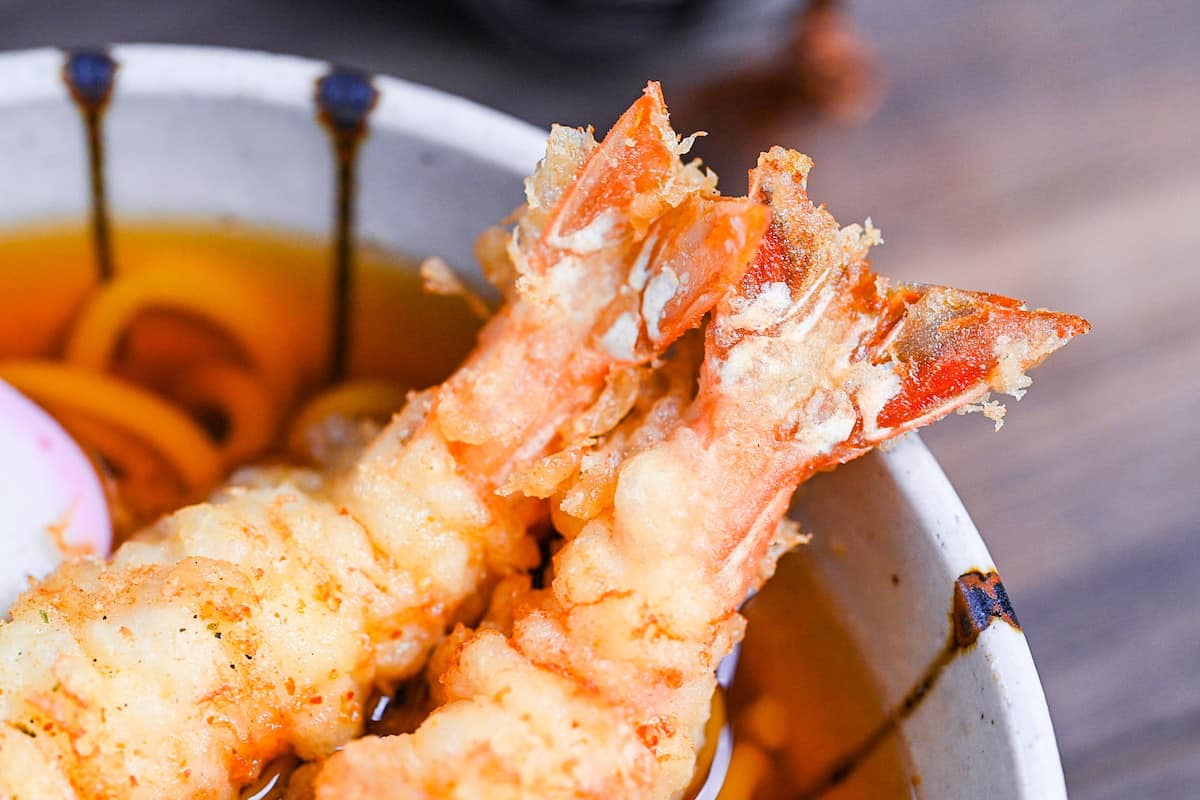
Visual Walkthrough & Tips
Here are my step-by-step instructions for how to make Japanese Shrimp Tempura Udon at home. For ingredient quantities and simplified instructions, scroll down for the Printable Recipe Card below.
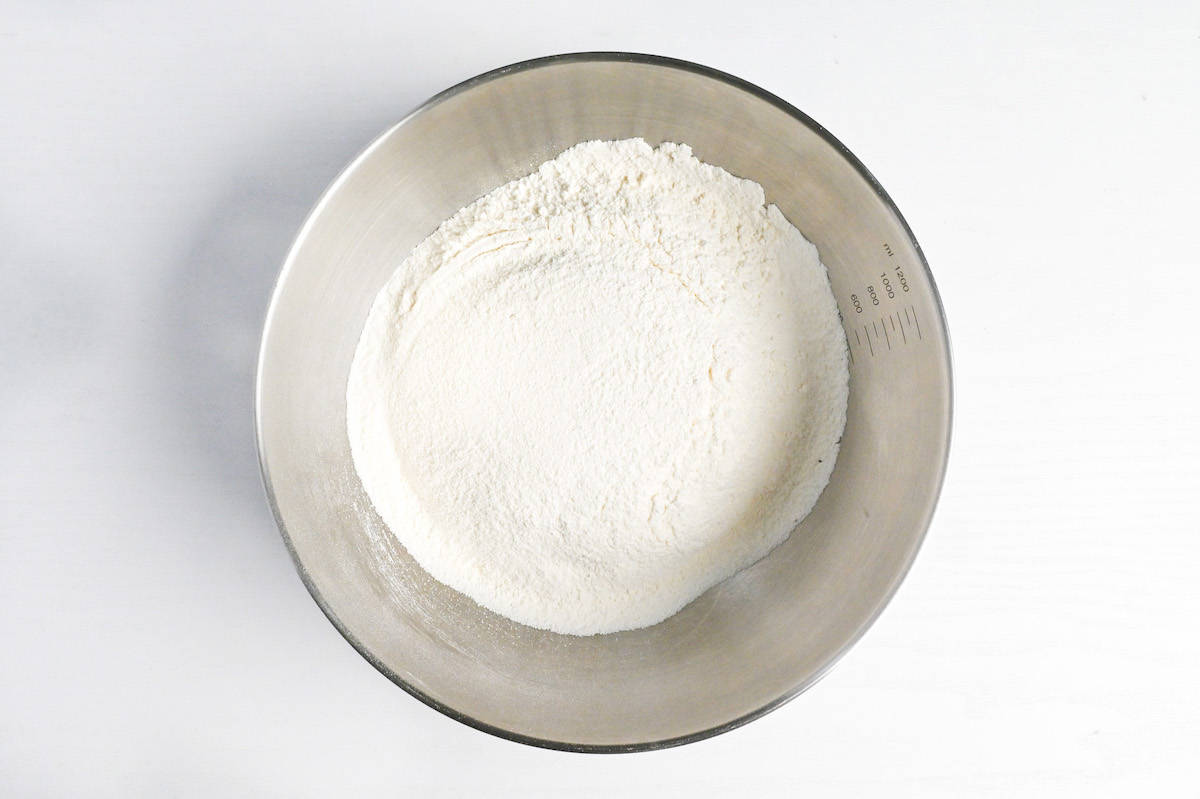
First, sift potato starch and cake flour into a bowl. Mix them well, and then place the bowl in the freezer.
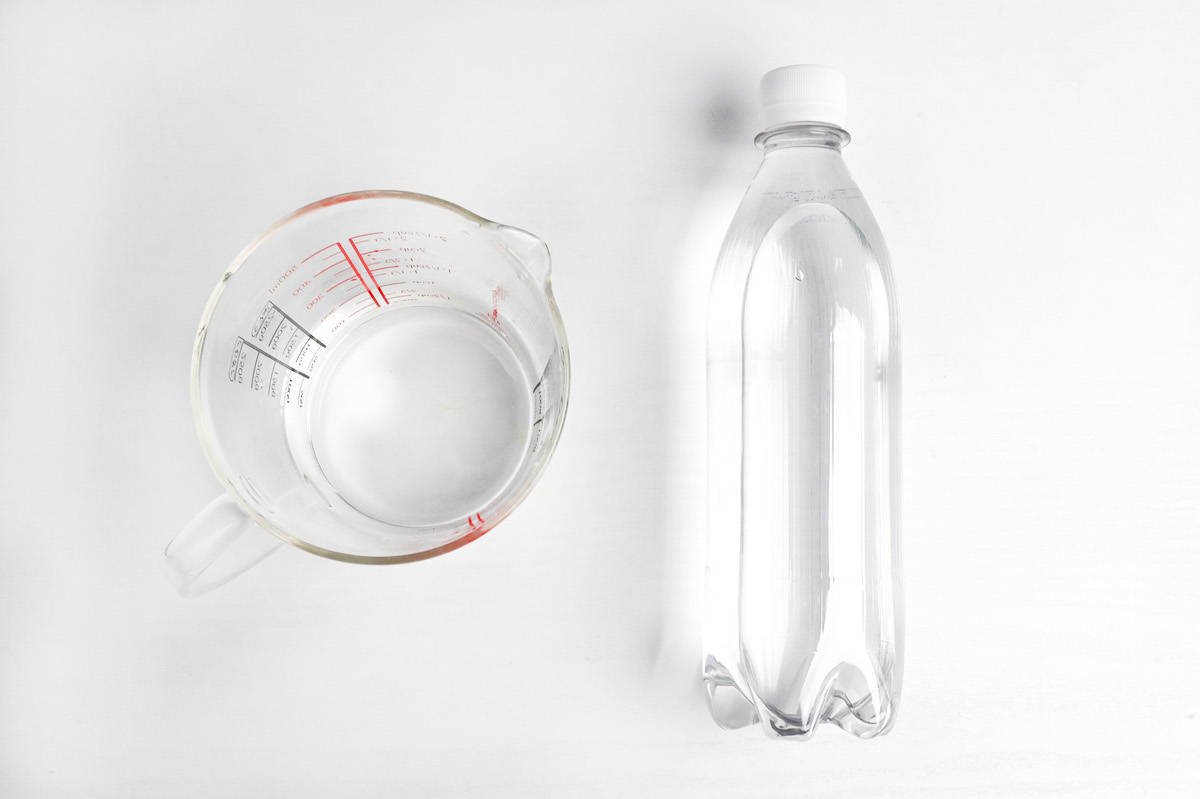
Next, pour water into a jug and put it in the fridge with a sparkling water bottle. In my experience, using cold ingredients makes a huge difference in the quality of tempura batter.
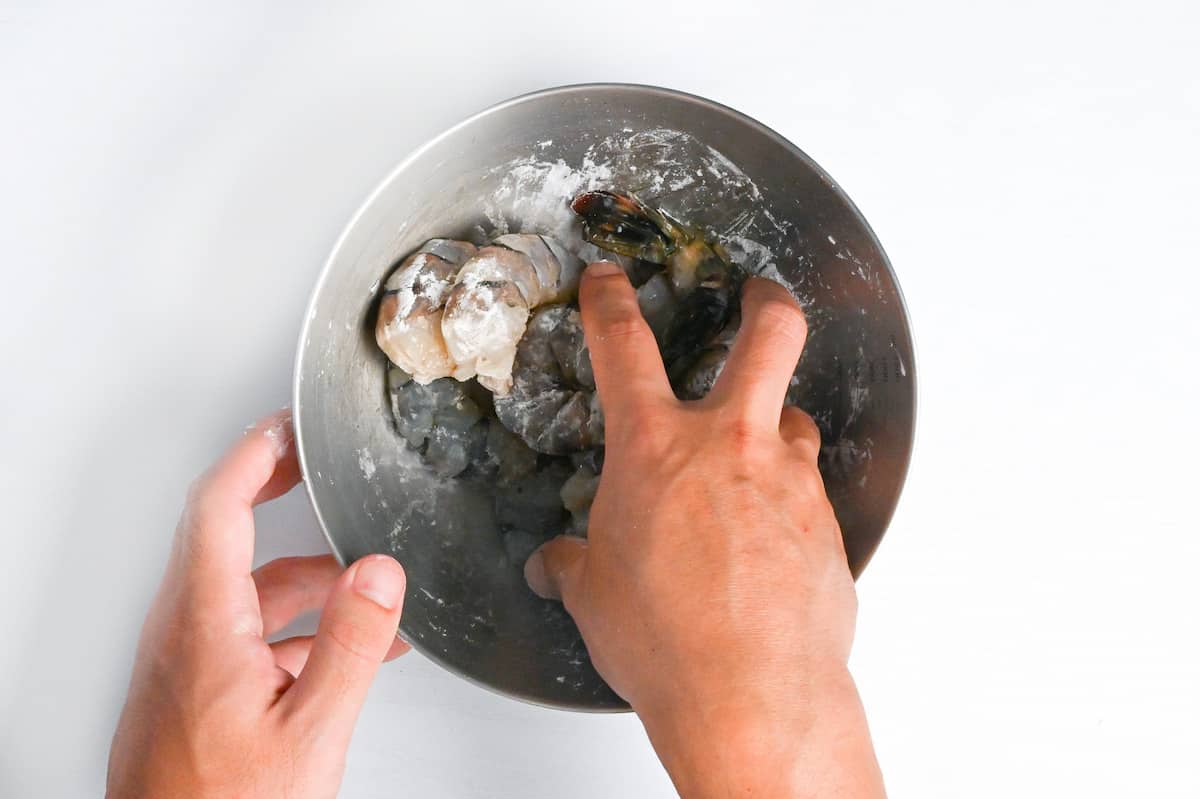
Place 8-10 large, deshelled, and deveined shrimp in a bowl. Sprinkle salt and cornstarch over the shrimp. If you use frozen shrimp, defrost them completely by running them under cold water.
Rub the salt and cornstarch mixture over the shrimp and wash them under cold water to remove excess. Pat them dry with kitchen paper and lay them on a chopping board.
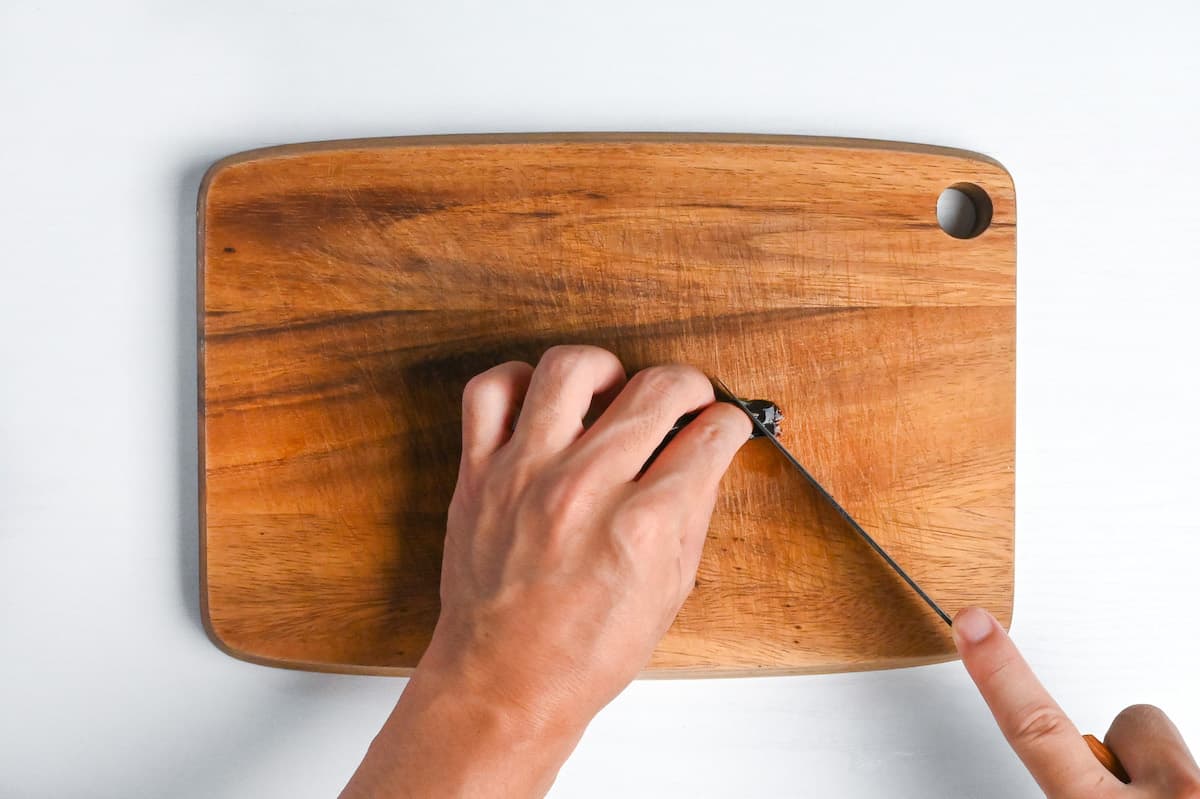
Lay each shrimp on its side, fold the tail in half, and trim it diagonally. Ensure that you cut off the pointy tip of the tail, as this will prevent oil splatters during frying and give the shrimp a neat appearance.
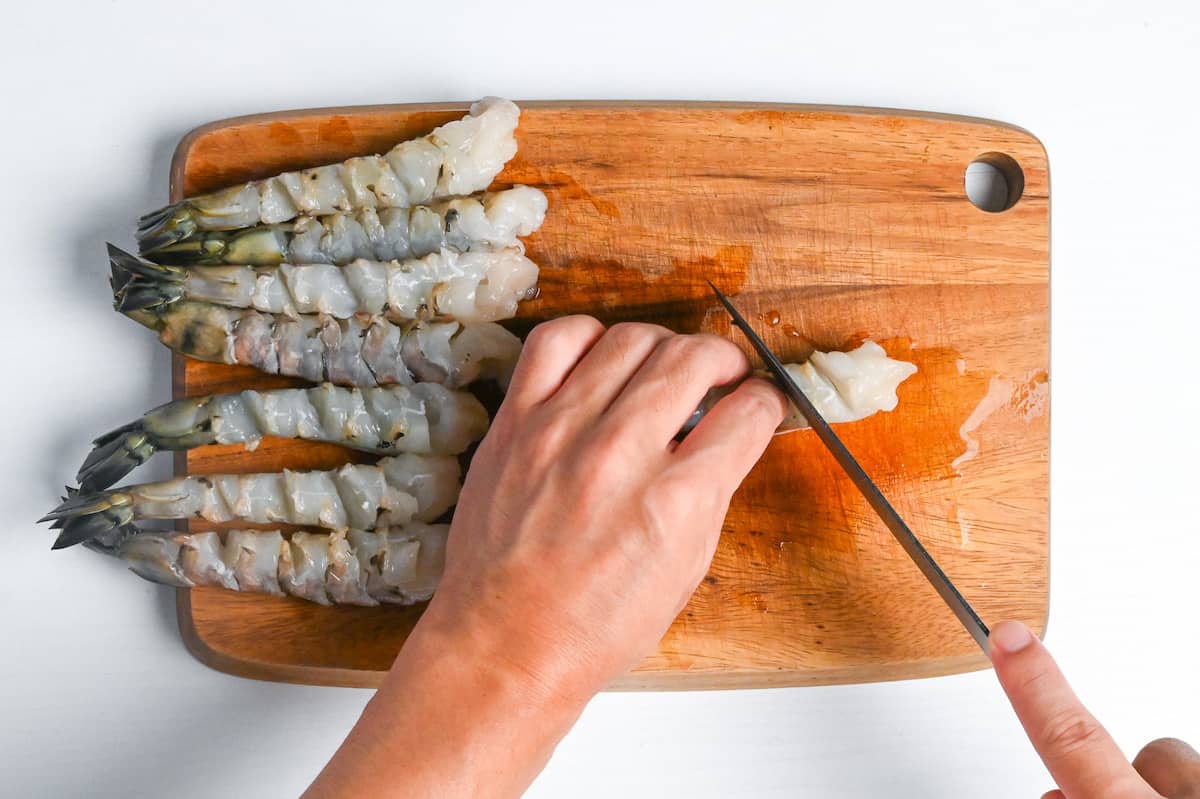
Turn the shrimp over and make diagonal incisions, roughly 1cm apart, along its body, cutting halfway through. Gently press the back of the shrimp to stretch the muscle and prevent it from curling during frying.
Rinse the shrimp in cold water again and pat them dry with kitchen paper. Keep the shrimp in the fridge until just before frying.
Remember, it is vital to keep the ingredients cold, so avoid leaving them out at room temperature for too long.
After 30 minutes have passed, it’s time to make the batter! First, take a bowl and mix a few tablespoons of chilled water with ½ tbsp of Japanese mayonnaise.
Mayonnaise is an excellent alternative to using eggs when making a small batch, as measuring half or a quarter of an egg can be challenging.
However, if you prefer eggs, the general usage ratio is 1 egg to 1 tbsp of mayonnaise.
Make sure to use mayonnaise that contains egg for this recipe. Note that the mayonnaise will not give any mayonnaise-like flavor to the batter, but it will work well in this recipe. I recommend using Kewpie mayonnaise.
Once you’ve combined the mayonnaise and chilled water, add the remaining chilled and sparkling water.

Next, add the flour/starch mixture in thirds, gently mixing with chopsticks to create a batter. Be careful not to whisk too vigorously.
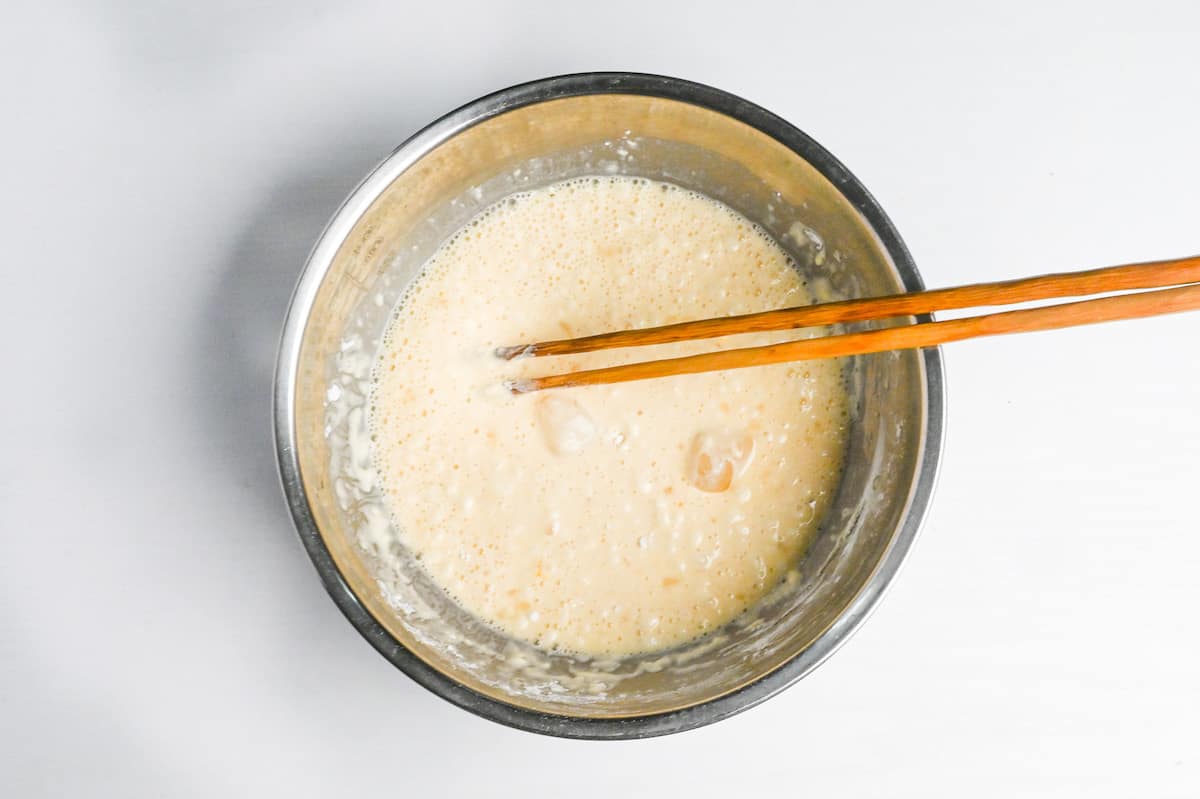
Add a couple of ice cubes to the batter to make your tempura extra crispy. This will help keep the batter cold during the frying process.

Preheat your frying oil to 180 °C and 190 °C (approx 355-375°F) to make delicious tempura. Maintaining the temperature is crucial, so I highly recommend using a contactless cooking thermometer to check it.
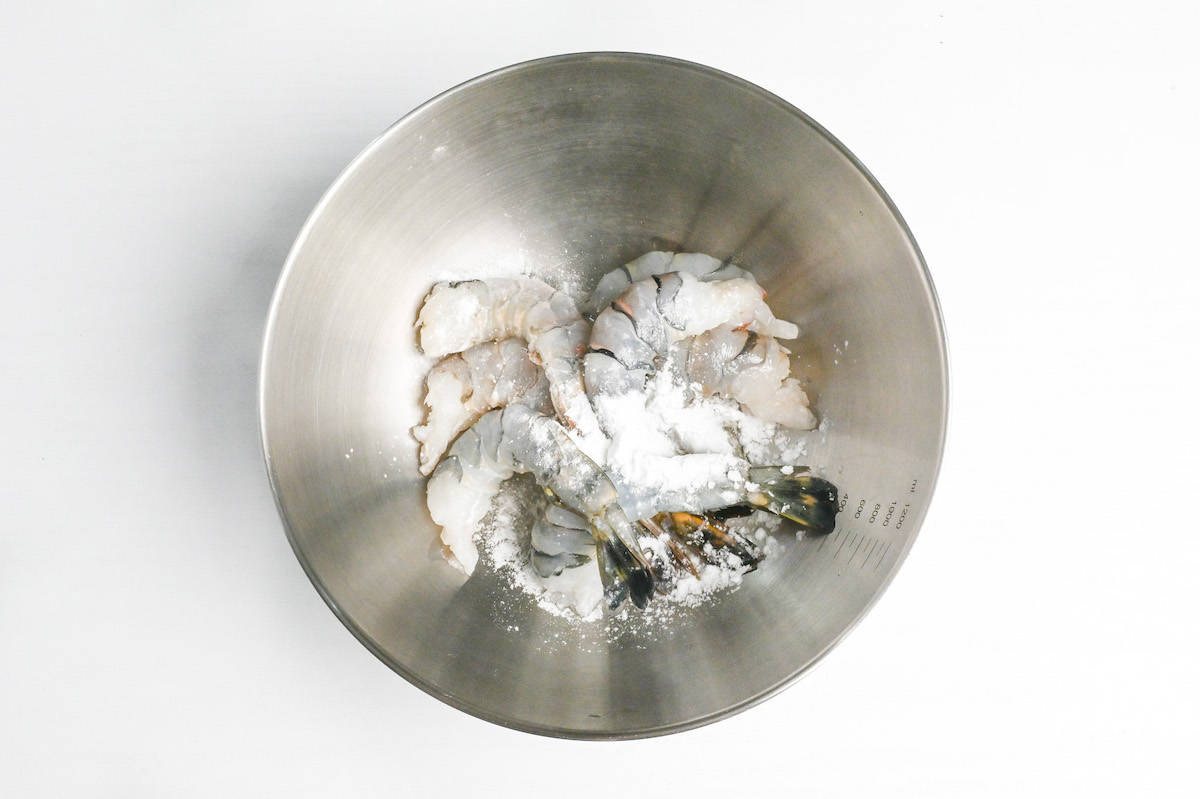
Dry the shrimp thoroughly with a paper towel and dust them with flour before battering. This will act as an adhesive and prevent the batter from coming off.
When dipping the shrimp in the batter, ensure a thin coat and fry them in small batches of no more than 4 to keep the oil temperature consistent and achieve crispy tempura.
A Japanese cooking technique for tempura is called “blooming (花揚げ).” In this technique, additional batter is dropped on top of the battered shrimp using chopsticks or hands while frying, creating a second layer of batter that resembles a blooming flower. This technique is especially suitable with tempura udon and soba!
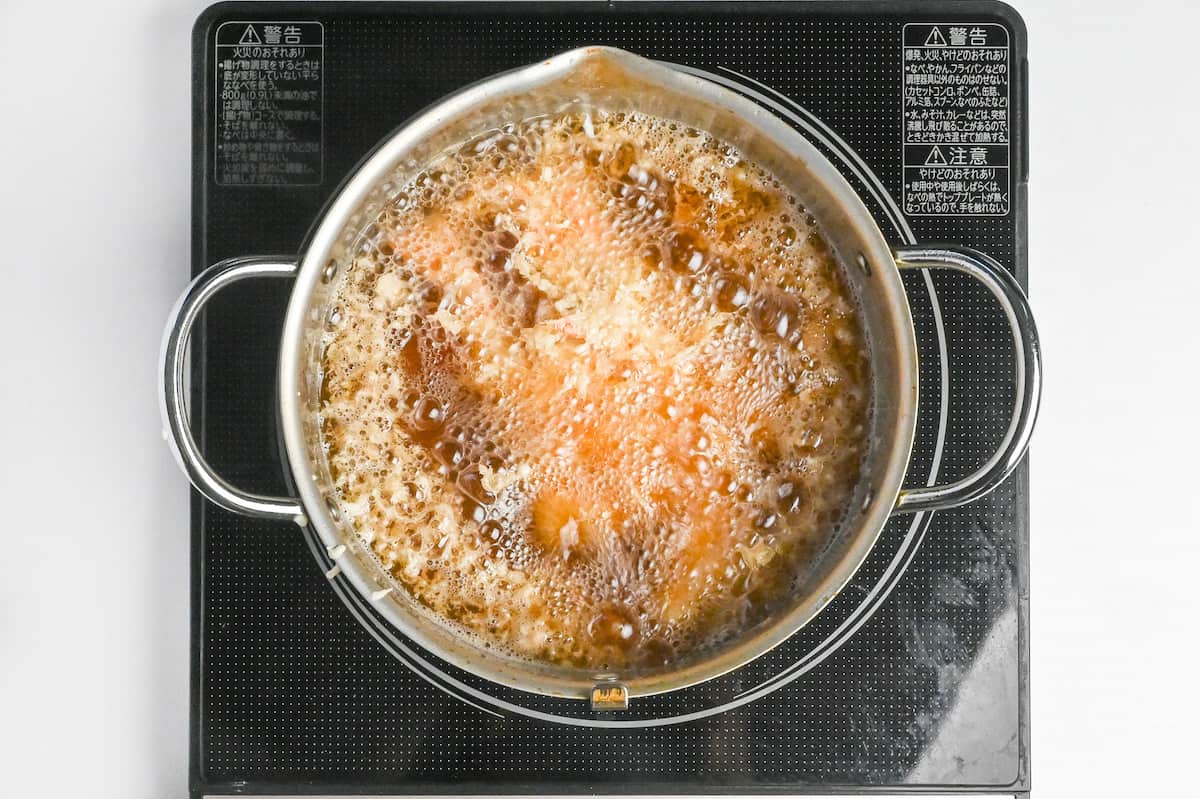
To determine when to remove the shrimp from the oil, look for a light golden surface, a loud crackling sound at the beginning of frying, a high-pitched sound at the end, and floating shrimp.
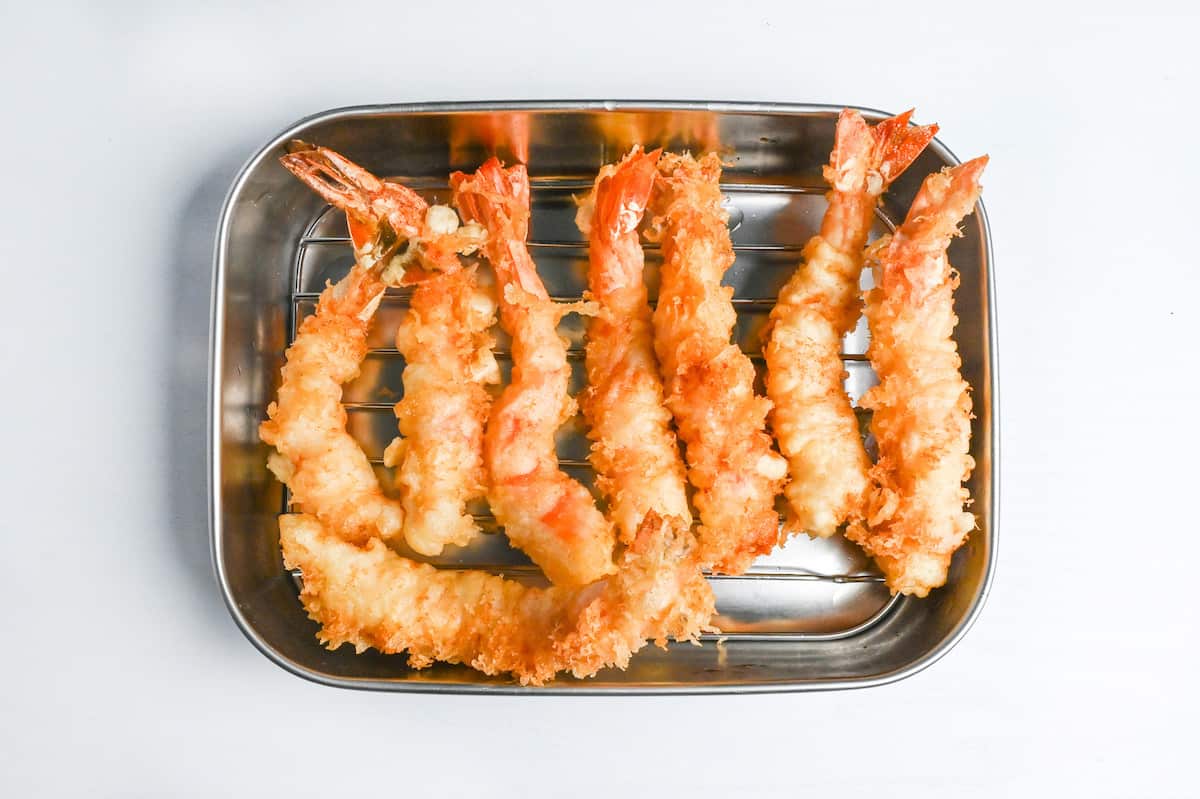
Once done, place them on a wire rack to drain any excess oil.
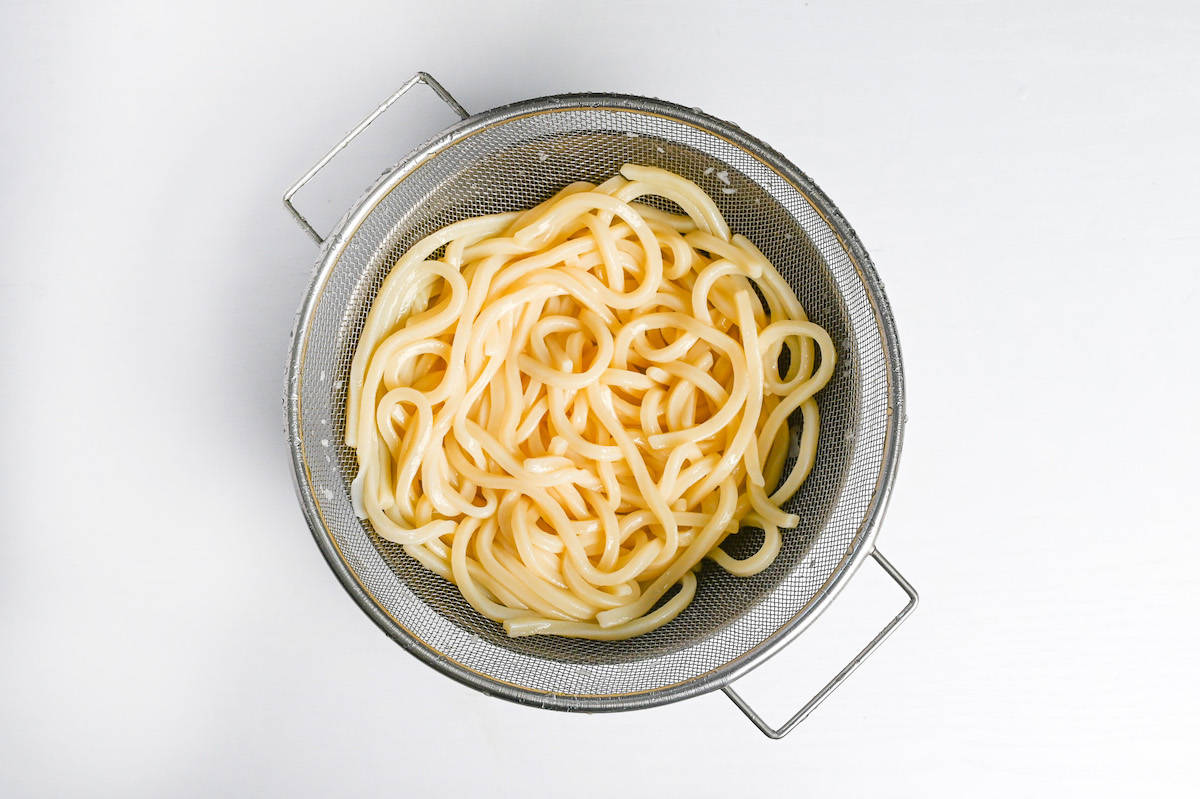
To prepare udon noodles, follow the instructions mentioned in the package. After cooking, drain and rinse them under hot water to remove excess starch.
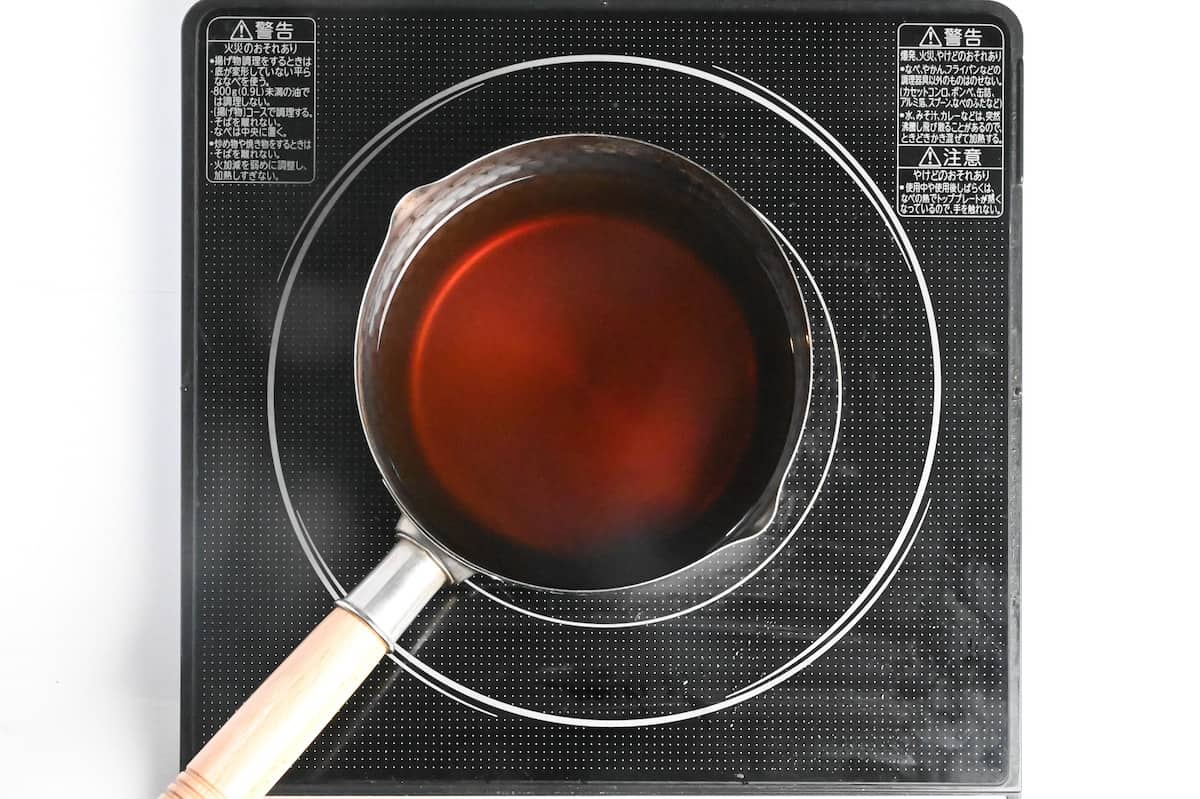
Next, bring the dashi stock to a boil and add soy sauce and mirin. Allow the mixture to boil for 2-3 minutes. Then, turn off the heat, add a pinch of salt, and mix everything well.
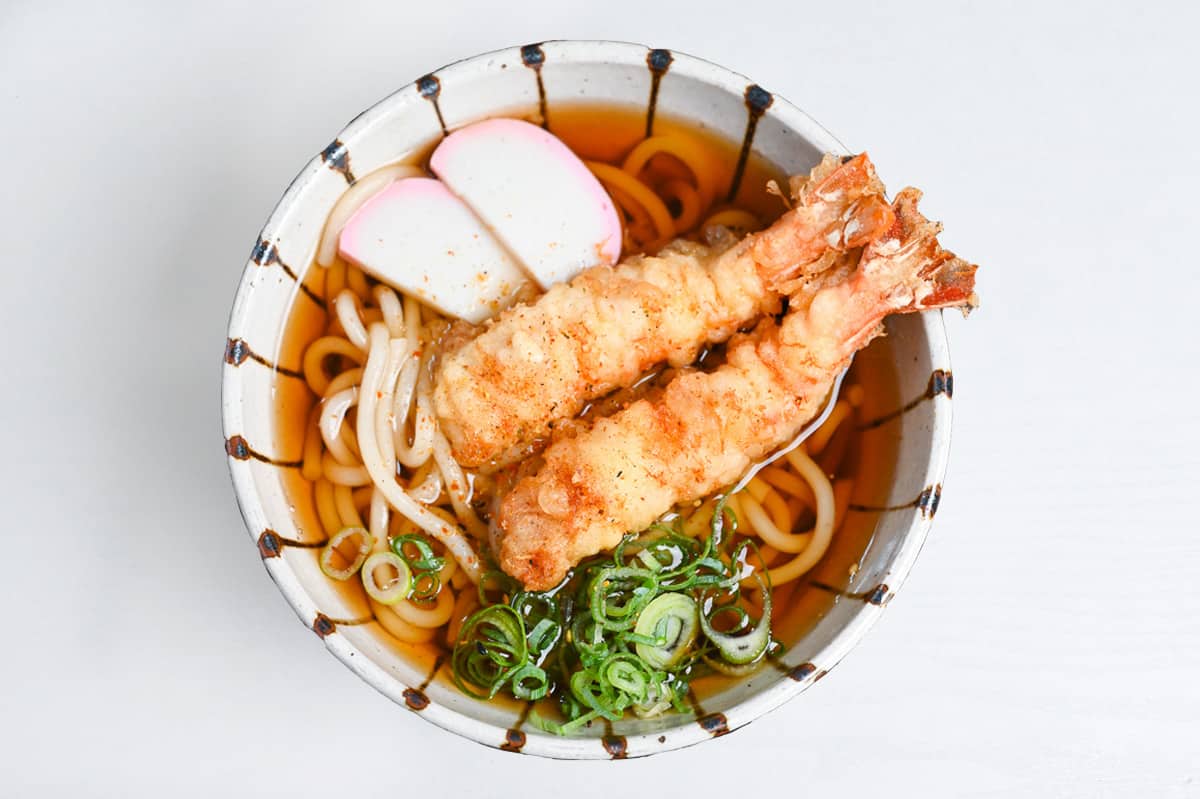
Divide the noodles among serving bowls and pour the broth over them. Top with the crispy shrimp tempura, garnish with green onions, and Japanese fish cake “kamaboko.” For a spicy kick, sprinkle some Japanese chili powder.
Jump to Full Recipe Measurements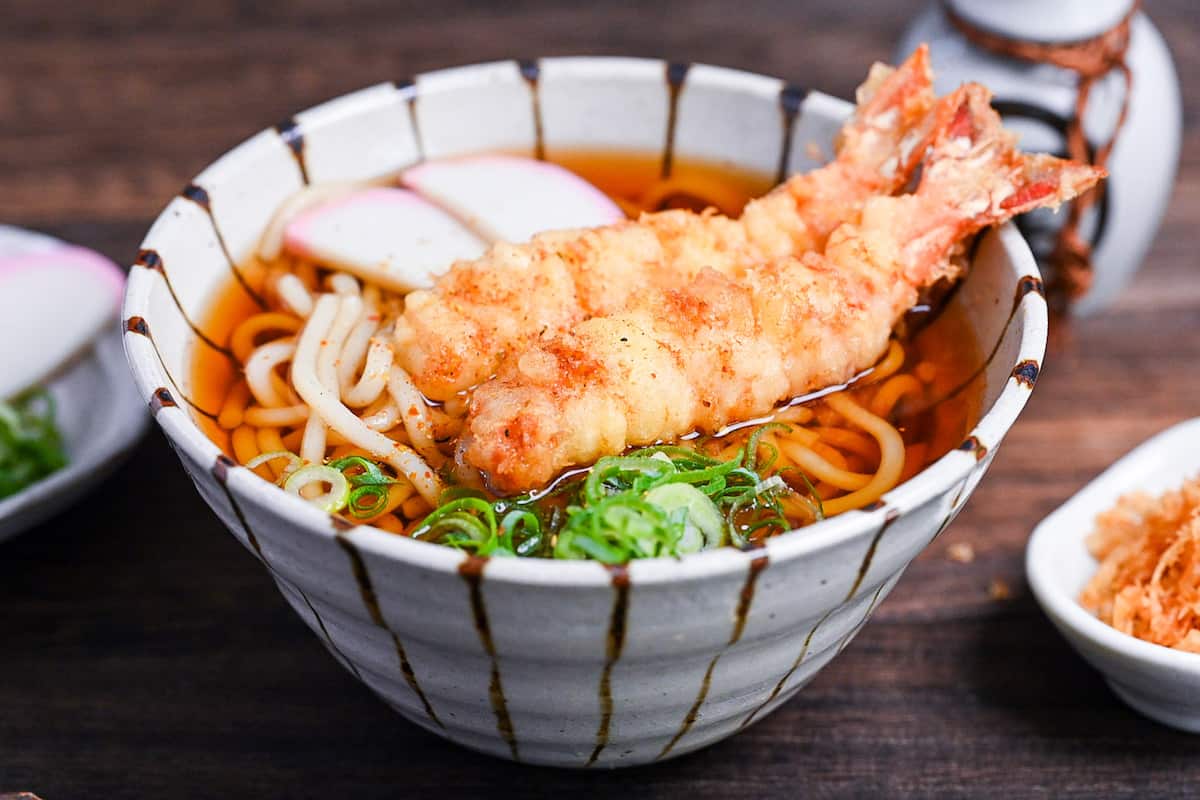
How to Store
Unfortunately, it is not recommended to store leftover tempura udon after combining the shrimp tempura and udon soup.
Instead, you can refrigerate or freeze shrimp tempura and udon soup separately.
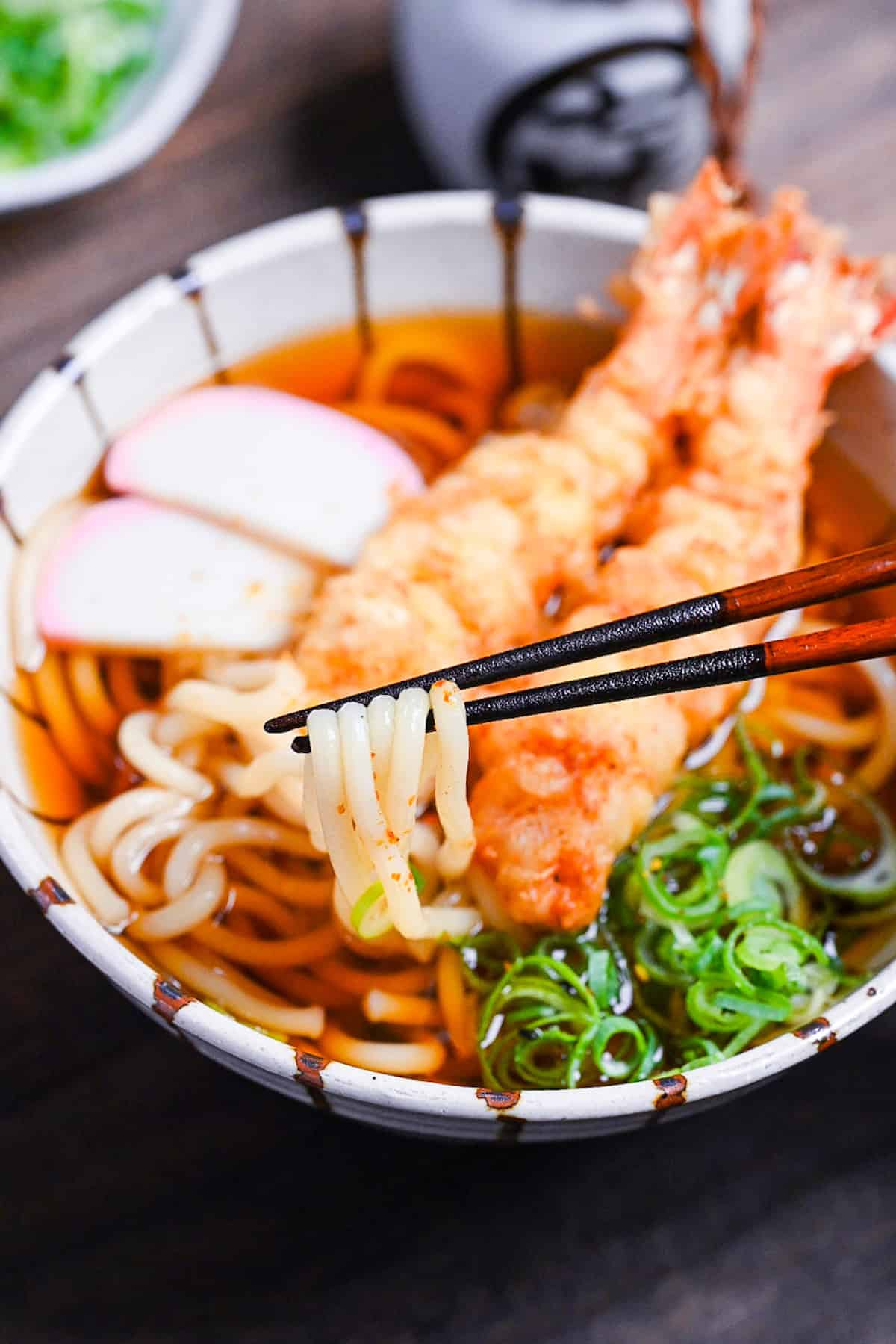
I hope you enjoy this Shrimp Tempura Udon recipe! If you try it out, I’d really appreciate it if you could spare a moment to let me know what you thought by giving a review and star rating in the comments below. It’s also helpful to share any adjustments you made to the recipe with our other readers. Thank you!
More Japanese Udon Recipes
- Beef Niku Udon
- Chicken Nabeyaki Udon
- Chicken Udon Noodle Soup (Tori Nanban Udon)
- Japanese Curry Udon
Want more inspiration? Explore my Udon Roundup Post for a carefully selected collection of tasty udon recipe ideas to spark your next meal!
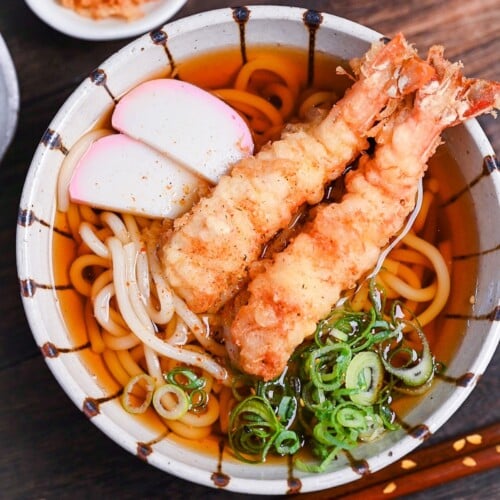
Shrimp Tempura Udon Noodle Soup (Ebiten Udon)
Equipment
- Wire strainer
Ingredients
Shrimp Tempura
- 100 ml cold water chilled
- 50 ml soda water (or club soda) chilled
- 75 g cake flour
- 15 g potato starch or cornstarch
- 8 black tiger shrimp or similar
- 2 pinches salt for washing the shrimp
- 1 tsp cornstarch for washing the shrimp
- all-purpose flour for dusting
- ½ tbsp Japanese style mayonnaise or ½ a whisked egg
- cooking oil for deep frying
Udon Broth and Toppings
- 1 liter dashi stock I recommend kombu & bonito dashi
- 75 ml soy sauce
- 30 ml mirin
- ½ tsp salt
- 4 portions udon noodles
- green onion finely sliced
- kamaboko fish cake 2-3 slices per portion – optional
- Japanese chili powder (shichimi togarashi) (shichimi) optional
Instructions
- Sift 75 g cake flour and 15 g potato starch into a mixing bowl and place in the refrigerator along with a jug of 100 ml cold water and an unopened bottle of sparkling water. Chill for 30 minutes.

Prepping the Shrimp
- First, deshell 8 black tiger shrimp, leave the tail on and remove the veins.

- Place the shrimp in a bowl with 2 pinches salt and 1 tsp cornstarch and rub it over the surface. The salt is to dehydrate them so they fry better and the corn starch helps clean them out.

- After a few minutes have passed, rinse the salt and cornstarch off the shrimp under cold running water and dry them with kitchen paper.

- Place a shrimp on a chopping board on its side with the tail folded in half and trim it diagonally. The pointy tip should be cut off and be the shorter part of the diagonal. (This stops oil from splattering out when it's frying and it looks nicer too.)

- Turn the shrimp so the belly is facing up and make shallow diagonal incisions along the whole body. The incisions should be about 1cm apart and go about 1/2 way through the prawn. You should be able to lay them out flat and straight.

Tempura
- Preheat your cooking oil to 180 °C (356 °F).

- Take the 100 ml cold water and pour it into a bowl along with 50 ml soda water (or club soda). Add ½ tbsp Japanese style mayonnaise to the water (or half a whisked egg) and mix until incorporated.

- Take the 75 g cake flour and 15 g potato starch from the fridge and add it to the bowl of water one-third at a time. Mix roughly between each addition. (It's fine if it still has lumps.)

- Test your oil by adding a drop of batter, if it floats and sizzles it's ready to start cooking. (Don't dip the shrimp in the tempura batter until the oil is ready). Once hot, dry your shrimp with kitchen paper and then lightly coat them in all-purpose flour or potato starch. Dust off any excess.

- Dip the shrimp in the batter and then place them in the oil one by one. Be careful not to overcrowd the pot. (I recommend keeping the batter in the fridge between batches.)

- Fry for about 2 minutes or once the batter puffs up and becomes crispy. Remove the tempura from the pot before they become golden and place them on a wire rack to allow the excess oil to drop off.

Udon noodle soup
- Boil 4 portions udon noodles in a separate pot, follow the instructions on the packaging. Once the udon noodles are ready, pour them into a colander and then rinse them under hot water to remove any excess starch.

- Bring 1 liter dashi stock to a boil and then add 75 ml soy sauce and 30 ml mirin. Boil for 2-3 minutes.

- Turn off the heat, add ½ tsp salt and mix.

- Divide them into serving bowls and pour the broth over the top.

- Place the tempura on top of the noodles and then garnish with green onion and kamaboko fish cake. For an added kick, sprinkle with Japanese chili powder.

- Enjoy!
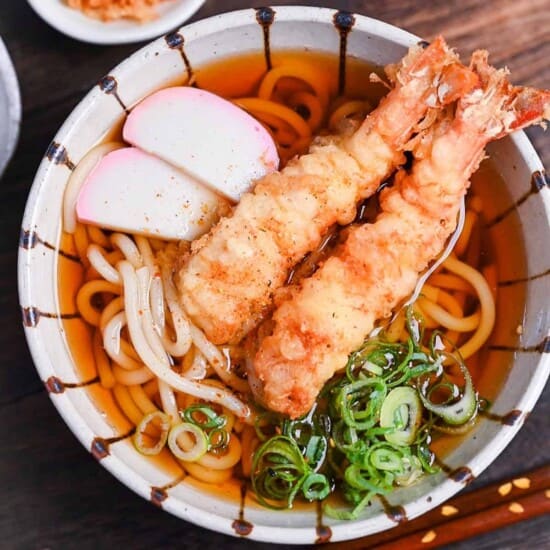


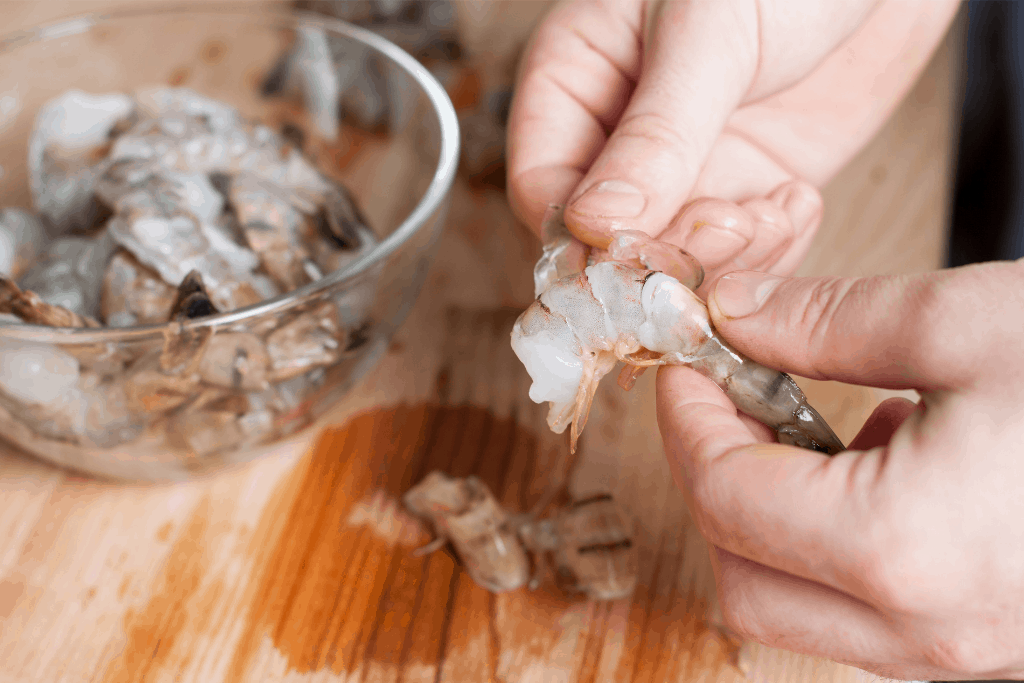
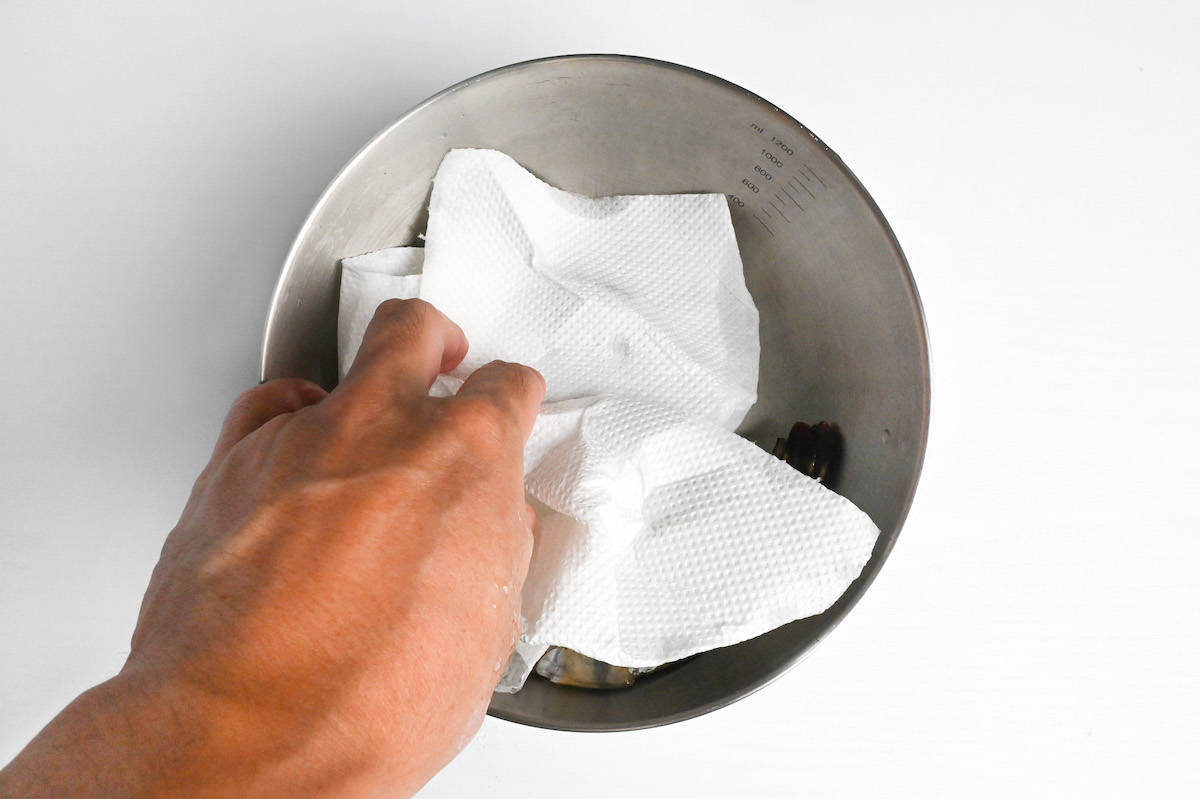
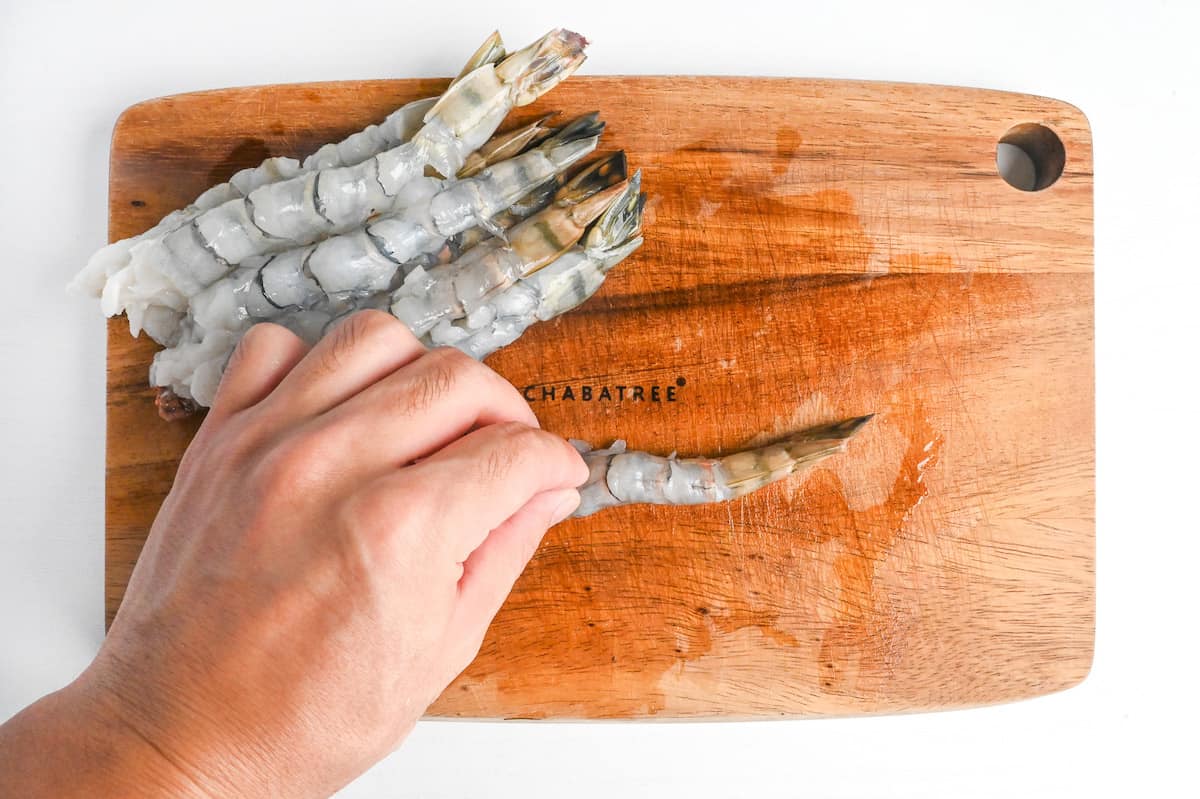
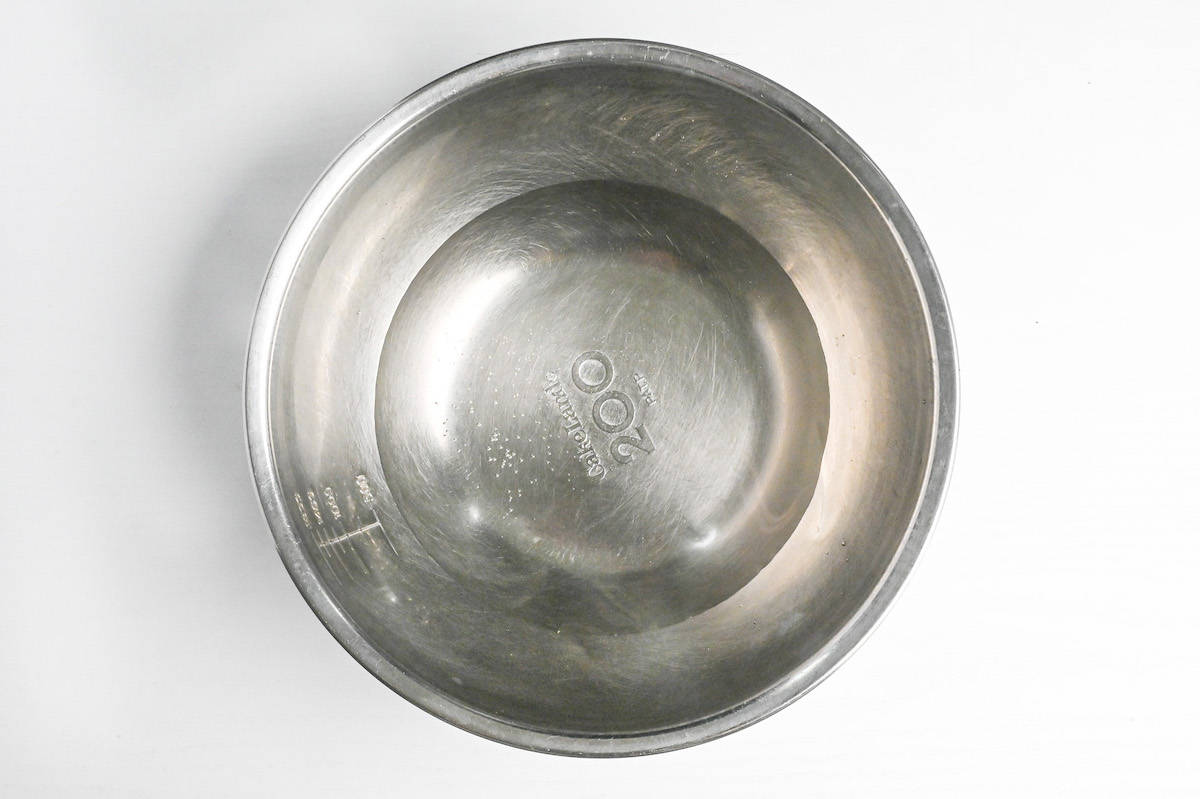
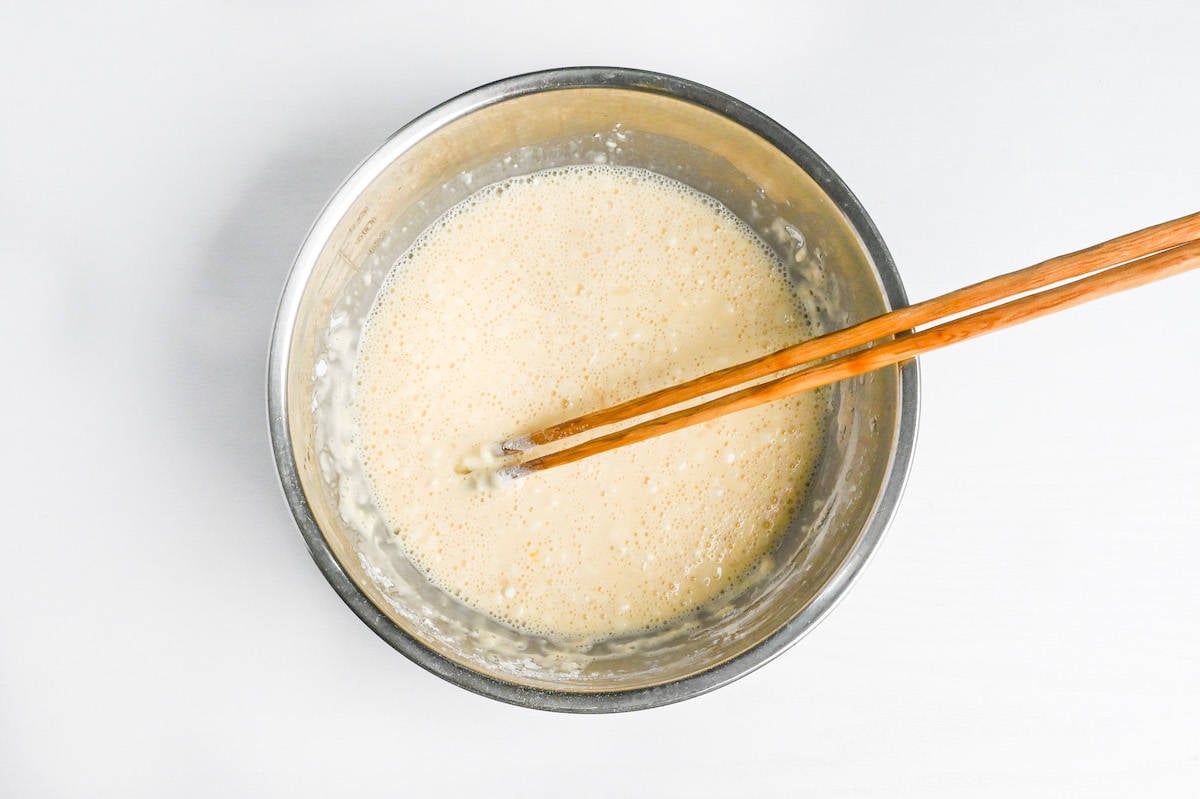
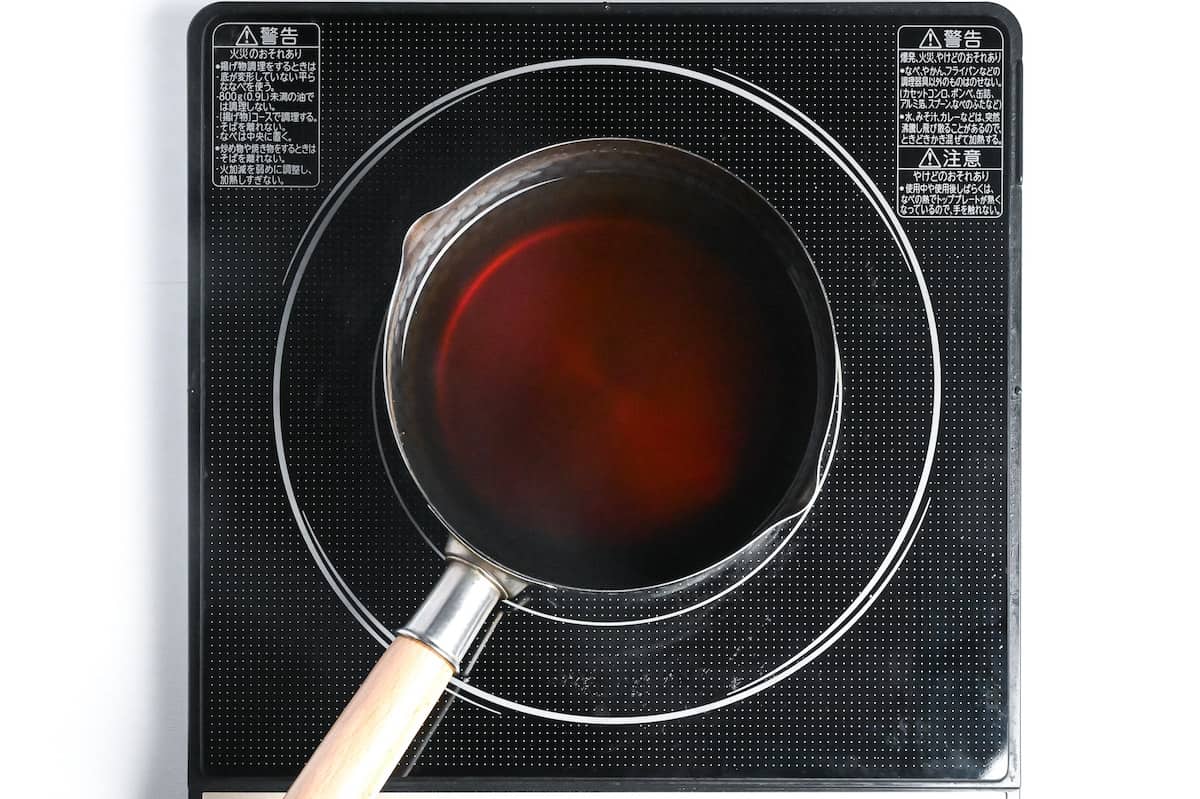
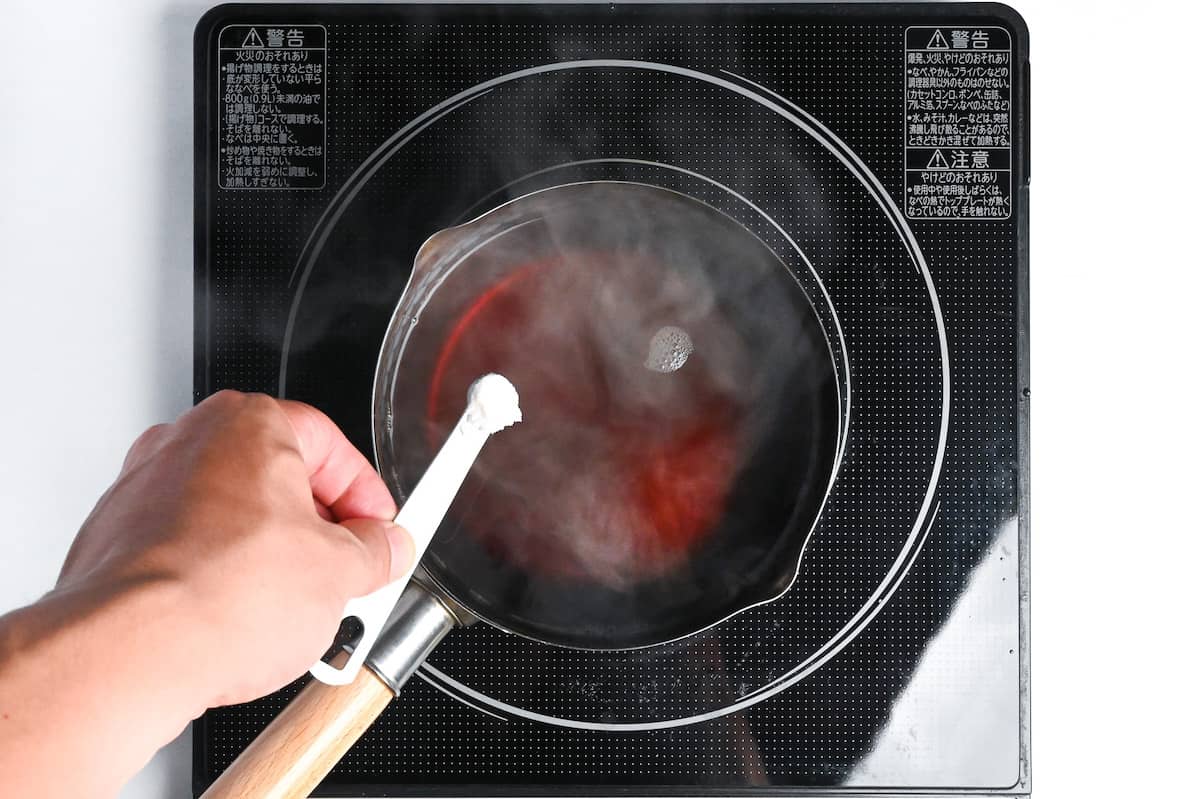
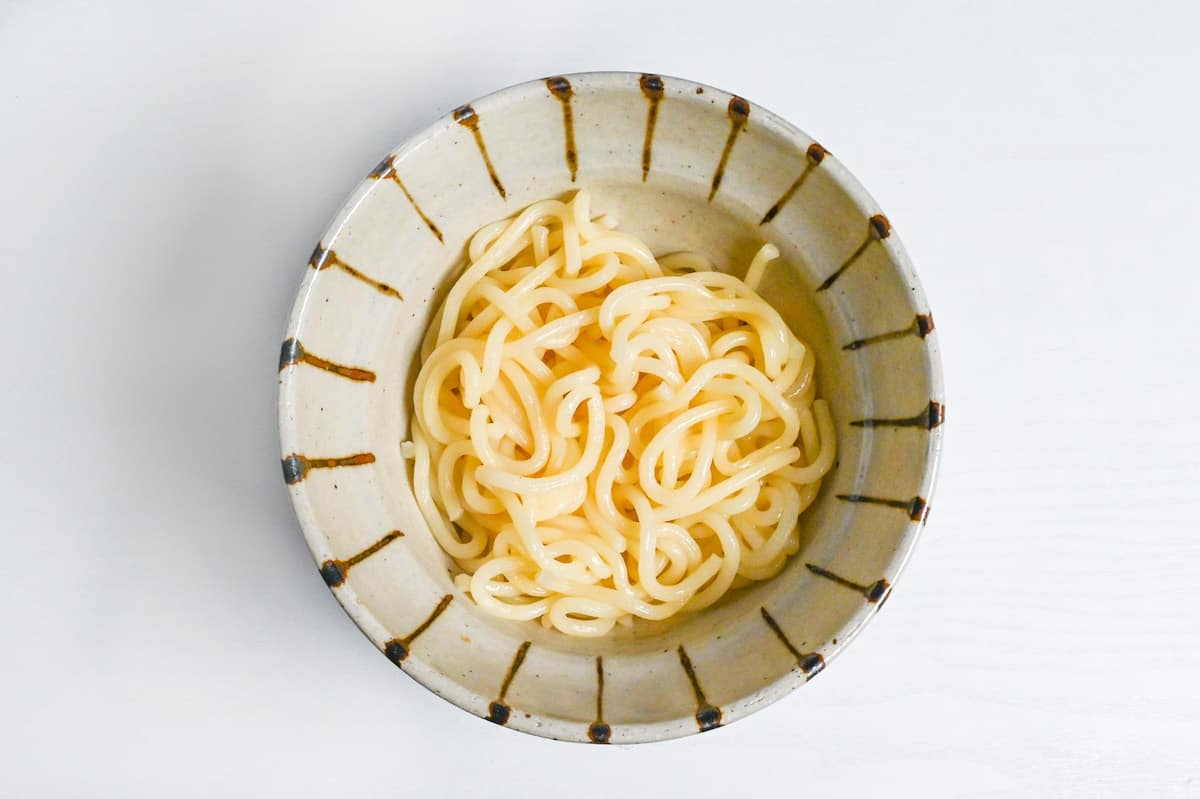

Absolutely fantastic! The whole family loved it. It was my first attempt at tempura (did vegetables as well as prawns) and it didn’t turn out too bad.
Thank you so much! I’m glad your family enjoyed the recipe 🙂